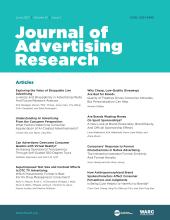Abstract
Direct-to-consumer prescription-drug television advertisements often contain superimposed text (supers) to convey information about the advertised product. This randomized experiment examined three size levels of supers and two levels of background contrast in direct-to-consumer advertisements. Participants (N = 1,272) watched different versions of a television advertisement for a fictitious asthma drug on either a flat-screen television or a tablet computer. Larger supers were more noticeable and memorable than smaller supers. High-contrast supers were less noticeable. Tablet users had more favorable views of the advertisement. Results have implications for the communication of important medical information in direct-to-consumer advertisements.
- Received March 10, 2019.
- Received (in revised form) July 24, 2019.
- Accepted January 16, 2020.
- Copyright © 2021 ARF. All rights reserved.
ARF MEMBERS
If you are a member of the Advertising Research Foundation, you can access the content by logging in here
Log In
Pay Per Article - You may access this article (from the computer you are currently using) for 30 days for US$20.00
Regain Access - You can regain access to a recent Pay per Article purchase if your access period has not yet expired.





